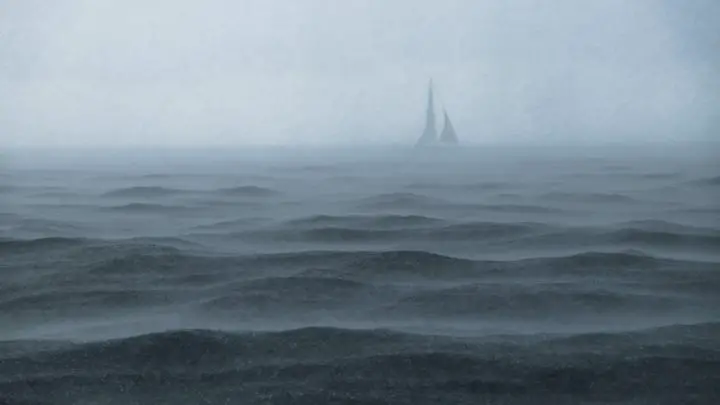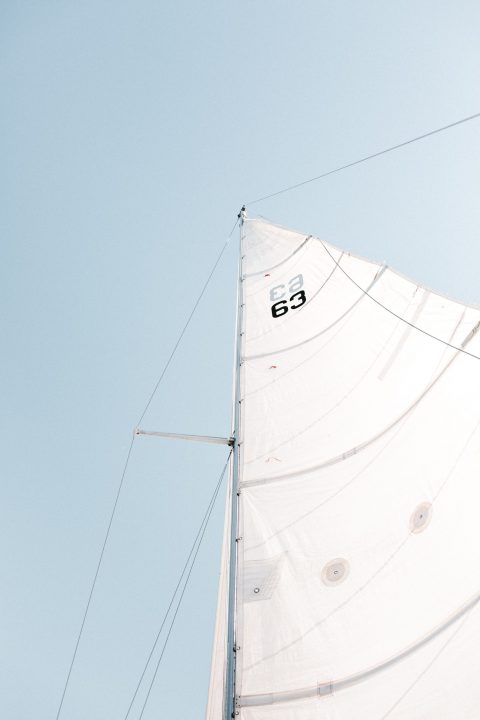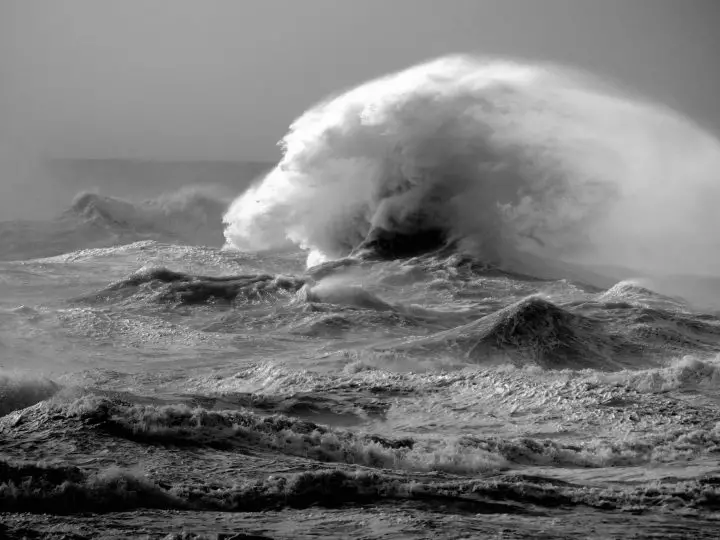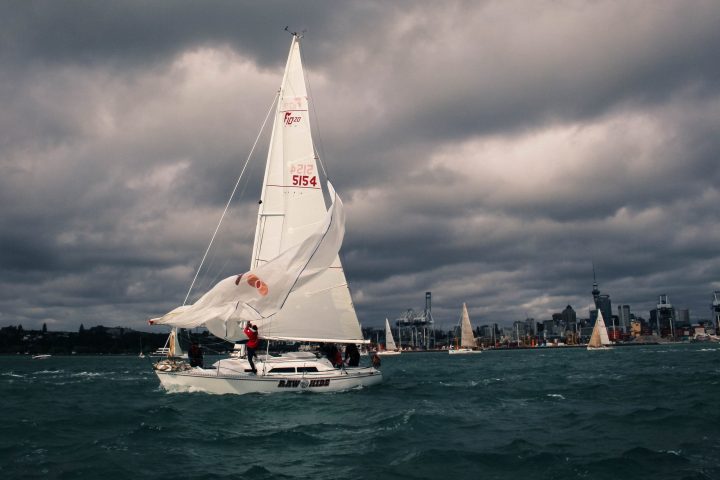If you’re new to sailing, you might be wondering what the best sailing wind speed is. It seems like an easy question, but the question strikes at the heart of the things that go into sailing a boat and being a good skipper.
Of course, there is no one perfect wind speed for sailing. Every skipper on the ocean will have a different answer. One will like the smooth and steady ride they get from their coastal cruiser when the wind blows at 12 knots. Another, sailing heavy offshore boats, won’t even bother putting the sails up with a minimum wind speed of 12 knots or less—but they don’t start having fun until it’s 18-20 knots.
But there’s even more! Those same two skippers might be handed those conditions one day and still complain! Now, 12 knots of wind on the nose means hours of tacking or running the motor for the coastal cruiser. The offshore sailor isn’t making enough progress downwind in 18 knots because the seas have built up too high from a storm and the ride is rough. On this day, neither skipper is happy with their usual comfortable sailing setup!
Table of Contents
- What is the Ideal Wind Speed for Sailing?
- How are Wind Speeds Measured?
- How Much Wind Do You Need to Sail?
- Wind Speed and Risk Management
- FAQs — Best Wind Speed for Sailing

What is the Ideal Wind Speed for Sailing?
To answer this question, we must make a few assumptions.
- You’re new to sailing and gaining experience
- You’re on a moderate-sized cruising boat, not a dinghy or a racer
- You’re looking to make miles and travel, not enjoy a lazy day on the water
- You are more interested in the comfort of your crew than getting there as fast as possible
In other words, this article assumes that you’re the average cruising sailor, traveling for pleasure to see the world by boat. So, if you are a weekend warrior out for the annual small boat race on the river, you might have completely different answers!
If these assumptions apply to you, you’ll probably find that the best sailing days are when the wind blows between 10 and 15 knots. This is enough wind to move even the heaviest boats, although not always very fast. It’s also a safe speed that any cruising-sized boat can handle easily, with the sails still being easy to handle and the boat easy to steer.
As you gain experience you will expand your comfort zone, as long as you boat safely and continue having fun. Once the winds start getting above 25 knots, even many experienced sailors will stay in port. High winds mean more serious training and large waves. When you’re in it for the fun, you’ll likely opt for the most comfortable sailing days, not the most challenging.
How are Wind Speeds Measured?
Before discussing the best wind speed for sailing, we should agree on how to measure the wind speed and look at how sailors get these numbers and interpret them.
One important consideration is how you get your information. For example, many boaters use apps and websites to calculate wind speed from global weather models like the GFS or the ECMWF. The problem with these numbers is that they are forecasts made on many assumptions and estimations that may not be perfect. They are especially limited in places where land interactions can drastically change the local wind patterns.
Besides weather forecasts, boats can get their wind measurements from buoy observations or their own boat’s anemometers (wind vanes). But anemometers have limitations too, and they are often not calibrated very well. Their location makes a big difference, too, since most weather forecasts and official observations are made for 10 meters off the water. So a deck-level wind vane will read a different number than a masthead-mounted unit.
Finally, there’s also the difference between stead winds and gusts. There seem to be many sailors who look at the steady wind forecast and ignore the gusts and then complain about how much windier it was than the forecast stated!

Wind Speed in Knots vs MPH
Remember when thinking about wind speeds for sailing to compare apples to apples. Nearly everything you measure on a boat is in knots—your speed over ground, hull speed, and the wind speeds you should put in a reef. So if your weather app is feeding you the information in miles per hour (MPH), do yourself a favor and eliminate the confusion. See if you can find an app that makes the conversion for you, or remember that 1 knot is equal to 1.15 statute miles per hour.
The Beaufort Wind Scale
The Beaufort scale is an old system for measuring wind speed based on the conditions that a sailor can observe out on the water. After all, our focus on the precise wind speed as displayed on a digital indicator is a modern fixation. Sailors have been plying the seas for generations without that technology, although having access to the information has undoubtedly made traveling by sea much safer.
Still, the wind scale helps understand the realms of wind speed and the associated conditions in each. It is not just the wind that should concern a sailor. They must also consider the sea state–the height of wind-blown waves plus the ocean swell.
The Beaufort scale is measured from 0 (dead calm) to 12 (survival storm conditions or hurricane). Distinct changes in the sea state mark each force. Knowing the Beaufort forces enables a sailor to estimate the wind force in knots without an instrument.
| Beaufort Force | Knots | Description | Sea State |
| 0 | < 1 | Calm | Smooth and mirror-like |
| 1 | 1-3 | Light air | Ripples |
| 2 | 4-6 | Light breeze | Small wavelets |
| 3 | 7-10 | Gentle breeze | Large wavelets, scattered whitecaps |
| 4 | 11-16 | Moderate breeze | Small waves 1-4 feet, numerous whitecaps |
| 5 | 17-21 | Fresh breeze | Moderate waves 4-8 feet, many whitecaps, some spray |
| 6 | 22-27 | Strong breeze | Large waves 8-13 feet, whitecaps and more spray |
| 7 | 28-33 | Near gale | Sea heaps up, waves 13-19 feet, foam streaks off breakers |
| 8 | 34-40 | Gale | High waves 18-25 feet, edges of which break into spindrift, foam blown in well marked streaks |
| 9 | 41-47 | Strong gale | High waves 23-32 feet, dense streaks of foam, spray reduces visibility |
| 10 | 48-55 | Storm | Very high waves 29-41 feet, overhanging crests, sea white with blown foam |
| 11 | 56-63 | Violent storm | Exceptionally high waves 37-52 feet, foam patches cover the sea, visibility lowered |
| 12 | 64 or more | Hurricane | Waves 45+ feet, air filled with foam, sea white with driving spray, visibility nil |

True vs Apparent Wind on Sailboats
There’s a big difference between the wind on the water and the wind on the boat. This concept is the definition of “apparent wind.” Apparent wind is that which is felt on the deck of the boat. It changes dramatically depending on the boat’s speed and direction. The opposite of apparent wind is “true wind,” which is the wind speed and direction on the water, without the effects of the boat.
It’s best explained through an example. Let’s imagine a hypothetical sailboat that can sail in any direction—even directly into the wind. Maybe it’s not sailing–it’s just motoring!
The wind is blowing out of the north at 10 knots. Our sailboat makes 5 knots—no matter which direction it is going.
If the boat is pointed north and directly into the wind, the apparent wind felt on the boat’s deck is 15 knots—10 knots of wind PLUS 5 knots of motor/sailing power. This is the wind in its sails, the breeze on your face, and everything else. Since 15 knots is a better speed to sail a boat, an upwind sail probably feels pretty good and might be called a “good working breeze.”
What if the boat turned around and went south? Then the apparent wind on deck would be only 5 knots—10 knots of wind MINUS 5 knots of sailing speed. It’s worth noting that most cruising boats do not sail well in winds less than 10 knots and probably will not be making way in winds of 5 or less.
And finally, what if the boat were on a beam reach, headed either due east or west? The apparent wind would be 10 knots since there is no component of the vessel’s speed to add or subtract.
For all points in between, the apparent wind would be something between 15 (maximum) and 5 (minimum). The exact amount would depend on how close to the wind direction the boat is maneuvering.
How Much Wind Do You Need to Sail?
The glimpse into the apparent wind in the example above probably provides clues as to how complicated the question of wind speed is on a boat. Now, let’s look at some of the other factors that play into this calculus.
Good Sailing Wind Speed for Sailing Upwind vs Downwind
The example above demonstrates that the best wind speeds for sailing depend significantly on the direction you’re going. There’s an adage—A sailor cannot change the wind, but they can adjust their sails. It’s just one more example of why traveling on a sailboat is challenging.
Generally, if you need to sail to a downwind destination, more true wind is favorable. This is because your apparent wind will be lower, so it takes more true wind to move the boat. Additionally, downwind sails are generally more comfortable anyway, since you are sailing with following seas and not pounding into it.
In our example above, a cruising boat trying to make miles probably could not be headed south without running its motor. If they were headed due north, they’d either have to tack back and forth, motor into the wind, or perhaps motor sail.
The opposite is true about sailing into the wind. If you’re on a beat, the best wind speed for your sail may be just enough to get the boat near its hull speed. Anything more may produce seas that slow the boat down.
Boat Displacement and Agility
Some of these effects have everything to do with the boat you’re standing on. Every sailboat in the world was designed for a specific set of circumstances. Some are designed very light with lots of sail area, while others are heavier to provide softer rides in rough seas and carry a lot of weight. Know your boat and know what it can and can’t do. Don’t expect a heavily laden, full keel ocean cruiser to sail downwind in 5 knots of apparent wind.
The choices might be different on a race boat that sails well in light air. The boat might have a large spinnaker, be lightly built and lightly loaded, and be able to sail well downwind in 5 knots of apparent wind. Sailing upwind, it might have better tacking angles and make better VMG (velocity made good, the speed at which you head directly towards your destination). Of course, this boat can travel faster, but it likely can’t hold all your stuff and allow you to live comfortably.
You can draw the same similarities in the catamaran and multihull sailing world. Just because it’s a catamaran does not mean that it will always sail fast. Many cruising catamarans are heavy, especially those that have been kitted out for living aboard. It might win a race with the monohull above sailing downwind in 5 knots of wind. Where the monohull is ghosting along at 2 knots, the cruising catamaran might be doing 2.5 or 3 knots.

Sailing in Various Weather Conditions and Wind Speeds
A look at the Beaufort wind scale provides another glimpse into factors that affect sailors. In anything more than a fresh breeze, the sea state begins playing a prominent part of the wind speed equation. The sea is constantly changing, and driving a sailboat up and down mountainous seas is like driving a car over hilly roads. The boat will slow down going uphill and surf down the wave quickly as it slides downhill.
But a lot of that depends on the timing of the seas. During big storms, seas build up for hundreds of miles in the open ocean and have a big period between them. So big ocean swells might not have much effect on a boat’s progress.
But many times in near-shore waters and places with currents, wind-driven waves pile up. When the wave period (measured in seconds) is equal or less to the wave height, they are called square waves. Square waves produce a very uncomfortable chop that can slow the progress of even the stoutest sailboat.
Regardless of the wave’s shape, the quality of the ride is important inside the vessel. A rough ride can be invigorating and fun if out sailing for an afternoon. But, if sailing overnight, rough seas taken too fast can become uncomfortable. On extended passage, you must take crew fatigue into account.
The takeaway is this—when figuring out the best wind speed for sailing, the choice can’t be made while ignoring the sea state. The perfect wind speed for sailing on a calm, protected bay might be way too much for open water, or you might need to begin reefing sooner.
Sail Selection
Finally, all boats are limited by the sails they have onboard. Most cruising sailors make do with a standard mainsail and a furling jib or genoa. Without adding a foresail designed explicitly for light airs, like an asymmetrical spinnaker, gennaker, or code zero, the boat will likely need 15-20 knots of true wind to sail at hull speed downwind.
On the other end of the spectrum, some boats might be risky to take out in conditions beyond a strong breeze without adding robust storm sails. Furling sails can and do come unfurled unexpectedly, and most furling systems are not built to withstand gale or storm-force conditions without careful use and constant inspections for chafe.
The Importance of Reefing
All of this highlights another vital topic in sailing—how to reef a sail. The ability to shorten sails to operate safely in higher winds is an integral part of negotiating the variety of conditions you will encounter on the water.
If you’re a day sailor, it’s possible you could pick your conditions and never have to reef. But reefing is essentially good boat handling—it is the ability to drive the car without having the “pedal to the metal” all the time. Controlling the power your sails make will make the boat sail better. It will reduce weather helm, excessive heeling, and in some cases, can increase your speed by increasing efficiency.
Wind Speed and Risk Management
In summary, what is the ideal wind speed for sailing? The answer is—it depends! It depends on your boat, your skill and experience, on the conditions on the water, on the direction you’re going, and probably many other things not listed here.
The fundamental takeaway should be this—as you grow as a sailor, you must learn to handle your boat in various realistic conditions. But at some point, the risk of danger outweighs the benefits. At 10 knots, the risks are low. At 20 knots, most cruising boats can handle almost anything, but reefing is a good idea. At 30 knots, if you aren’t reefed and in control, things can go bad quickly. Finally, at 40 knots of wind or more, you should be heavily reefed for heavy weather.
One parting thought–remember that boating isn’t always about sailing. Most of us have to return to a crowded marina and a tight slip after a sporty day of sailing, and most sailboats are not great when being handled in close quarters. So until you’ve had some safe high wind close-quarters maneuvering in your boat, make sure conditions will allow you to dock safely.
FAQs — Best Wind Speed for Sailing
What is the best wind speed for sailing?
The best wind for sailing is the one that propels the boat without using the motor in the direction you want to go, which provides a comfortable and safe ride.
Unfortunately, no sailor can control the speed of the wind for sailing. So instead, sailors learn to control what they can. They can put out or take in sail, they can set a different course, they can start their motors, or they can stay in port and go sailing another day.
How windy is too windy for sailing?
It depends on your boat and your experience level. With its sails reefed, you can safely sail most cruising sailboats in winds up to 30 knots. Beyond the 30 knot line, most pleasure sailors will choose to stay in port to avoid the rough ride and extra work it will take to handle the boat. However, the number is arbitrary since every boat and every skipper is different.
Is 10 mph wind good for sailing?
Ten miles per hour (8.6 knots) of wind is a good wind speed to learn to sail. It is enough wind to fill the sails and provide power for the boat to move, but the control lines will be lightly loaded. The boat will be moving at a leisurely and pleasant pace in most cases.
It does depend on the boat’s size and direction, however. In light winds like 10 mph, downwind sailing in a big boat will be very slow. So 10 mph is fun for a day on the water and suitable for sailing lessons and dinghy sailing, but not quite enough for quick travel by sailboat if you’re trying to get somewhere.
Is 15 mph wind strong for boating?
In the open ocean, 15 mph (13 knots) of wind is described as a moderate breeze. You can expect small waves of one to four feet to form. This is likely a nice day on the water for sailboats and larger powerboats. Small boats, however, may find the conditions very rough. Of course, local conditions like those found in an inlet could be unsafe for even a bigger boat in a 15 mph wind, so always seek local knowledge when boating in unfamiliar waters. Alternatively, 15 mph wind on a protected body of water like a lake or bay may produce only a light chop and be an ideal wind speed.
